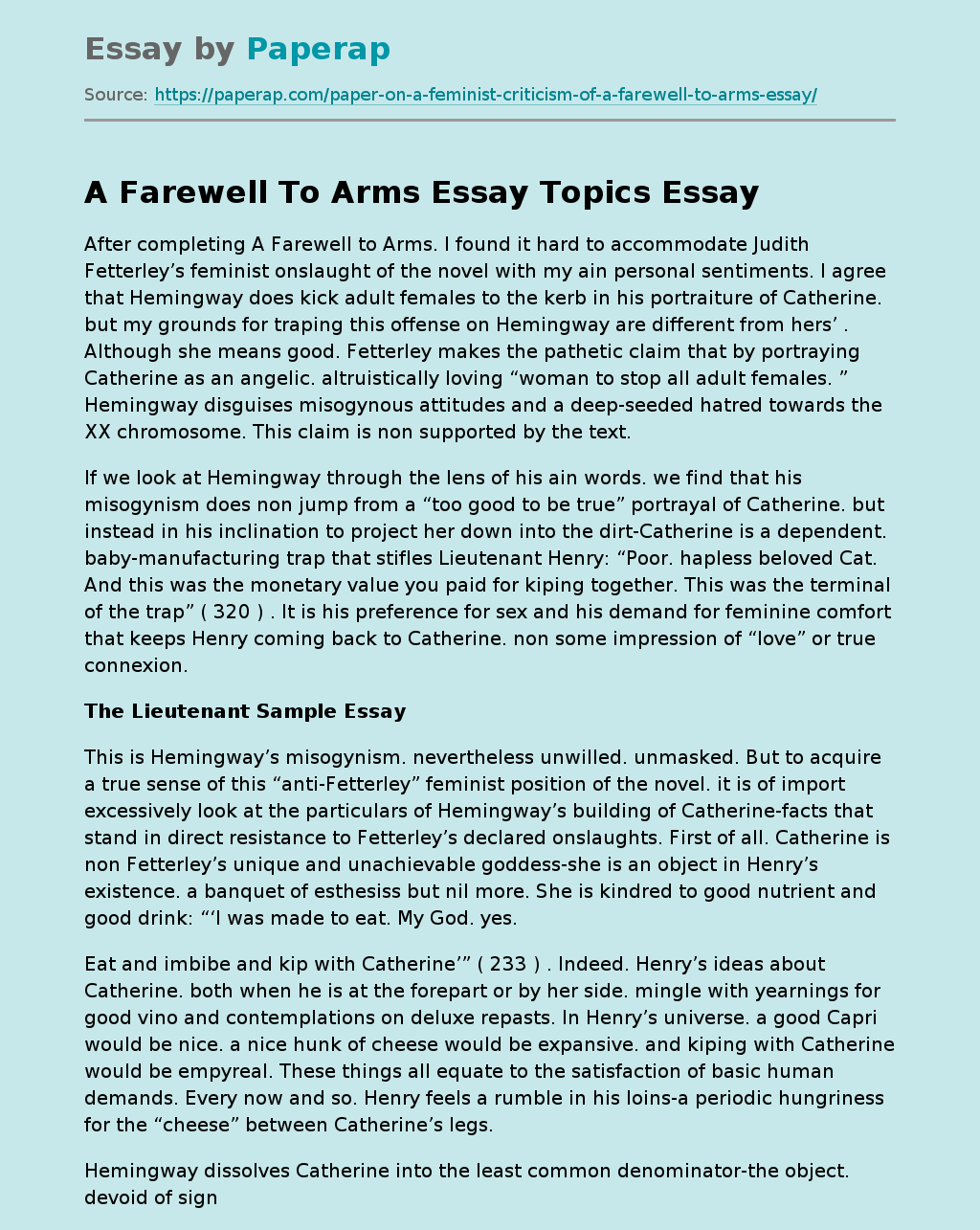"A Farewell to Arms"
The following example essay on “A Farewell to Arms” is an analysis of Ernest Hemingway’s 1929 literary work, which tells of love set against the backdrop of World War I. The essay reveals the plot of the novel and reveals the images of the main characters of the story.
After completing A Farewell to Arms. I found it hard to accommodate Judith Fetterley’s feminist onslaught of the novel with my ain personal sentiments. I agree that Hemingway does kick adult females to the kerb in his portraiture of Catherine.
but my grounds for traping this offense on Hemingway are different from hers’ . Although she means good. Fetterley makes the pathetic claim that by portraying Catherine as an angelic. altruistically loving “woman to stop all adult females. ” Hemingway disguises misogynous attitudes and a deep-seeded hatred towards the XX chromosome. This claim is non supported by the text.
If we look at Hemingway through the lens of his ain words. we find that his misogynism does non jump from a “too good to be true” portrayal of Catherine.
but instead in his inclination to project her down into the dirt-Catherine is a dependent. baby-manufacturing trap that stifles Lieutenant Henry: “Poor. hapless beloved Cat. And this was the monetary value you paid for kiping together. This was the terminal of the trap” ( 320 ) . It is his preference for sex and his demand for feminine comfort that keeps Henry coming back to Catherine. non some impression of “love” or true connexion.
This is Hemingway’s misogynism.
nevertheless unwilled. unmasked. But to acquire a true sense of this “anti-Fetterley” feminist position of the novel. it is of import excessively look at the particulars of Hemingway’s building of Catherine-facts that stand in direct resistance to Fetterley’s declared onslaughts. First of all. Catherine is non Fetterley’s unique and unachievable goddess-she is an object in Henry’s existence. a banquet of esthesiss but nil more. She is kindred to good nutrient and good drink: “‘I was made to eat. My God. yes.
Eat and imbibe and kip with Catherine’” ( 233 ) . Indeed. Henry’s ideas about Catherine. both when he is at the forepart or by her side. mingle with yearnings for good vino and contemplations on deluxe repasts. In Henry’s universe. a good Capri would be nice. a nice hunk of cheese would be expansive. and kiping with Catherine would be empyreal. These things all equate to the satisfaction of basic human demands. Every now and so. Henry feels a rumble in his loins-a periodic hungriness for the “cheese” between Catherine’s legs.
Hemingway dissolves Catherine into the least common denominator-the object. devoid of significance or existent importance ( when Henry isn’t hungry ) . How can Catherine be an angel. as Fetterley claims. when she is simply an object. a little. rocklike satellite revolving Planet Henry? This leads us to another facet of Hemingway’s intervention of Catherine. In the novel. she is a wholly dependent and subservient slave to Henry and his desires-she is placed steadfastly under his heel. This is apparent from her duologue: “‘I’m good.
Aren’t I good? You don’t want any other misss. make you? … You see? I’m good. I do what you want’” ( 106 ) . Through her words. we get a sense that the lone thing that concerns Catherine is the degree of Henry’s satisfaction. She needs his blessing ; he is the beginning and terminal of her universe. This dependence resurfaces many times in the novel.
In Milan. Catherine works herself to the bone all twenty-four hours. so that she can hold sex with Henry all dark. Throughout this period. her greatest concern is that she doesn’t tack up to the misss that he has had in the yesteryear: “‘I’ll state merely what you wish and I’ll do what you wish and so you will ne’er desire any other girls’” ( 105 ) .
When she is pregnant. her ideas and concerns continue to focus on wholly around Henry’s felicity: “‘But after she’s Born and I’m thin once more I’m traveling to cut it ( her hair ) and so I’ll be a all right new and different miss for you’” ( 304 ) . Even during her long and backbreaking labour. Catherine’s individual concern is that she is a load on Henry: “‘Oh. I wanted so o have this babe and non do problem. and now I’m all done and all gone to pieces and it doesn’t work’” ( 322 ) .
Fetterley might claim that this amounts to “selfless-love. ” but I think this phrase gives Catherine ( and Hemingway ) excessively much recognition. Catherine. as portrayed in the text. seems more like an obedient Canis familiaris so a virtuous. unselfish being of visible radiation ; she is like a cur that serves its maestro because it has no 1 else and can non last on its ain. By the terminal of the novel. Hemingway succeeds in portraying Catherine as both an object and a docile topic in Lieutenant Henry’s land.
This building diminishes Catherine’s character and allows Henry ( and Hemingway ) to see her and the babe wholly in footings of the load they entail. They are a “trap”-flames that burn the log that “Henry the ant” scurries around on. This makes it much easier for Hemingway to kill off Catherine and rinse Henry’s custodies of all responsibility-the concluding pieces in his misogynous mystifier. This rough return is a more well-founded alternate to Fetterley’s women’s rightist onslaughts on the novel.
"A Farewell to Arms". (2019, Dec 05). Retrieved from https://paperap.com/paper-on-a-feminist-criticism-of-a-farewell-to-arms-essay/

